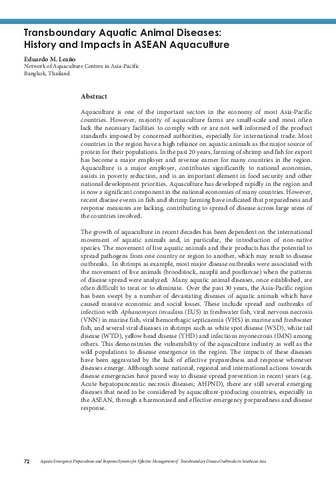Current fish disease problems in the Philippines and their economic impact
- Global styles
- MLA
- Vancouver
- Elsevier - Harvard
- APA
- Help

閲覧/開く
日付
1987Page views
14,271ASFA keyword
AGROVOC keyword
Taxonomic term
Metadata
アイテムの詳細レコードを表示する
Share
抄録
An account is given of fish disease problems facing the aquaculture industry in the Philippines. The Laguna de Bay fish kills that occurred in December 1985 and February 1986, involving epizootic ulcerative syndrome of bottom dwelling fish species, and the economic impact on the industry are discussed in particular. Soft-shelling disease of giant tiger prawn (Penaeus monodon), gas bubble disease and various other bacterial disease problems are also considered.
Type
Conference paperCollections
- Conference Proceedings [298]
Related items
Showing items related by title, author, creator and subject.
-
Transboundary aquatic animal diseases: History and impacts in ASEAN aquaculture
Leaño, Eduardo M. (Aquaculture Department, Southeast Asian Fisheries Development Center, 2019)Aquaculture is one of the important sectors in the economy of most Asia-Pacific countries. However, majority of aquaculture farms are small-scale and most often lack the necessary facilities to comply with or are not well ... -
Advances in diagnosis and management of shrimp virus diseases in the Americas
Lightner, Donald V. (Aquaculture Department, Southeast Asian Fisheries Development Center, 2002)The most important diseases of cultured penaeid shrimp, in terms of economic impact, in Asia, the Indo-Pacific, and the Americas, have infectious etiologies. Although diseases with bacterial, fungal, and parasitic etiologies ... -
Acute hepatopancreatic necrosis disease (AHPND) of penaeid shrimps: Global perspective
Bondad-Reantaso, Melba G. (Aquaculture Department, Southeast Asian Fisheries Development Center, 2016)The Organization for Economic Cooperation and Development (OECD) and the Food and Agriculture Organization (FAO) of the United Nations Agricultural Outlook 2015-2024 reported that fisheries production worldwide is projected ...





